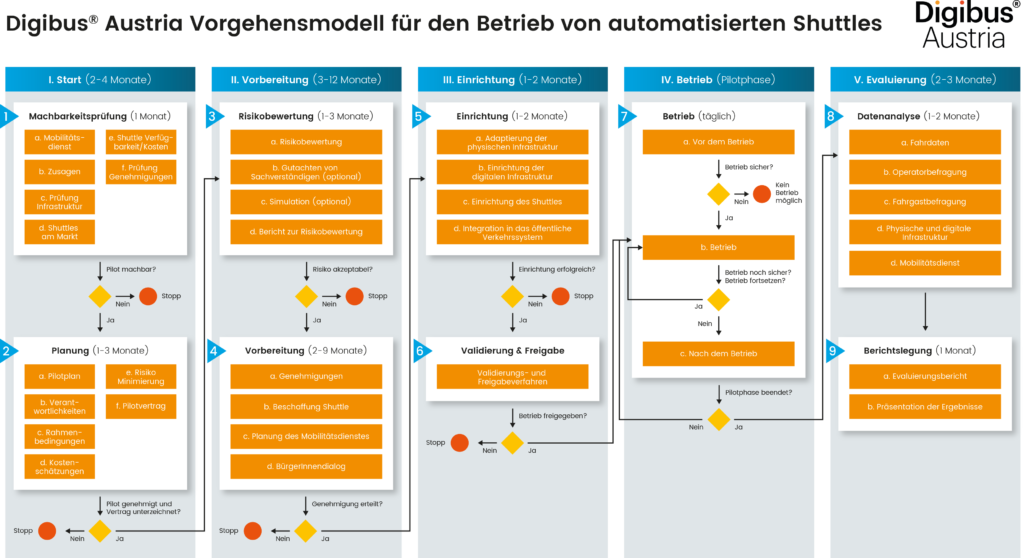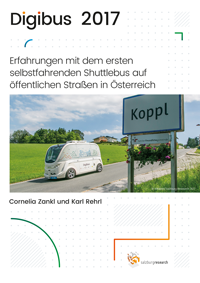Results from the Austrian flagship project Digibus® Austria incl. predecessor project:
Project Video with Results
Mit dem Klick auf das Bild werden durch den mit uns gemeinsam Verantwortlichen Youtube (Google Ireland Limited) das Video abgespielt, auf Ihrem PC Skripte geladen und Cookies für die Dauer von bis zu 2 Jahren gespeichert sowie personenbezogene Daten erfasst. Mit Hilfe der Cookies ist Youtube in der Lage, die Aktivitäten von Personen im Internet zu verfolgen und Werbung zielgruppengerecht auszuspielen. Datenschutzerklärung von Youtube
Driverless Test:
Mit dem Klick auf das Bild werden durch den mit uns gemeinsam Verantwortlichen Youtube (Google Ireland Limited) das Video abgespielt, auf Ihrem PC Skripte geladen und Cookies für die Dauer von bis zu 2 Jahren gespeichert sowie personenbezogene Daten erfasst. Mit Hilfe der Cookies ist Youtube in der Lage, die Aktivitäten von Personen im Internet zu verfolgen und Werbung zielgruppengerecht auszuspielen. Datenschutzerklärung von Youtube
Digibus® Austria Procedure Model for the Operation of Automated Shuttles

In the Austrian flagship project Digibus® Austria, a detailed procedure model was developed that guides potential operators of automated shuttles step by step from the planning to the operation of self-driving shuttles in order to plan and implement a safe and reliable operation of automated shuttles on public roads.
To the Procedure Model (in German)
Presentation with Results
On 25 March 2021, the results from the Austrian flagship project were presented in an online event.
To the PPT slides from the final event [in German]
Publications
| Organisation | Zitat | Konferenz | Download |
|---|---|---|---|
| Salzburg Research | Cornelia Zankl, Karl Rehrl (2018): Digibus 2017: Experiences with the first self-driving shuttlebus on open roads in Austria. | Paper und Vortrag bei Transport Research Arena (TRA) in Wien, Session: Automated Transport: Concepts, Applications, Results | Siehe Seitenende |
| Salzburg Research | Rehrl, K., Zankl, C. Digibus©: results from the first self-driving shuttle trial on a public road in Austria. Eur. Transp. Res. Rev. 10, 51 (2018). | Paper publiziert bei ETRR (European Transport Research Review) als eines der Top paper der TRA | https://doi.org/10.1186/s12544-018-0326-4 |
| Salzburg Research | Rehrl, K. (2018): Special Interest Session; “EU SIS23 Deployment of autonomous shuttles on public roads Experiences from five different countries”. | ITS World Congress 2018, Copenhagen | [coming soon] |
| BOKU | Roman Klementschitz, Tobias Haider, Maria Angerer, Philipp Haydn, Alfons Bauernfeind (2019): Potenziale für den Einsatz gemeinschaftlich genutzter autonomer Fahrzeuge im ländlichen Raum. | 24th International Conference on Urban Planning and Regional Development in the Information Society, GeoMultimedia 2019 2-4 April 2019; Karlsruhe Institute of Technology, Germany | https://archive.corp.at/cdrom2019/papers2019/CORP2019_19.pdf |
| Salzburg Research | Rehrl, K. (2019): SIS11 – Automated Shuttle Trials – Learnings, best practices and next challenges. | ITS European Congress 2019, Eindhoven | [coming soon] |
| Universität Salzburg | Alexander G. Mirnig and Alexander Meschtscherjakov. 2019. Trolled by the Trolley Problem: On What Matters for Ethical Decision Making in Automated Vehicles. | CHI Conference on Human Factors in Computing Systems Proceedings 2019 https://chi2019.acm.org/ | https://doi.org/10.1145/3290605.3300739 |
| Universität Salzburg | Alexander G. Mirnig: “Hey driver, where are we going?“ End User Interaction With Autonomous Public Transportation & Autonomous Shuttles”. | Car HMi Europe https://www.car-hmi.com | Link |
| Universität Salzburg | Alexander G. Mirnig, Magdalena Gärtner, Vivien Wallner, Sandra Trösterer, Alexander Meschtscherjakov, and Manfred Tscheligi. 2019. Where Does It Go? A Study on Visual On-Screen Designs for Exit Management in an Automated Shuttle Bus. | 11th International ACM Conference on Automotive User Interfaces and Interactive Vehicular Applications (AutoUI 19) | https://doi.org/10.1145/3342197.3344541 |
| Universität Salzburg | Alexander G. Mirnig, Magdalena Gärtner, Sandra Trösterer, Alexander Meschtscherjakov, Manfred Tscheligi: “Suppose your bus broke down and nobody came: A study on error management in an automated shuttle bus”. | 11th International ACM Conference on Automotive User Interfaces and Interactive Vehicular Applications (AutoUI 19) | AUI19_plus2_abstract.rtf |
| Universität Salzburg | Peter Fröhlich, Matthias Baldauf, and Alexander G. Mirnig. 2019. 2nd workshop on user interfaces for public transport vehicles: interacting with automation. | 11th International ACM Conference on Automotive User Interfaces and Interactive Vehicular Applications (AutoUI 19) | https://doi.org/10.1145/3349263.3350766 |
| BOKU | Paul Pfaffenbichler, Astrid Gühnemann, Roman Klementschitz, Günter Emberger, Simon Shepherd: A systemic analysis of environmental impacts of individual and shared automated mobility in Austria. | AET – 47th European Transport Conference, Dublin 2019, 9-11 October 2019. | [coming soon] |
| BOKU | Klementschitz R. (2019): Driverless shuttles and mobility in rural areas. | New Babylon 3 – Een Zienswijze op de Toekomst van de Zwinregio, 13. September 2019, Oostburg, NL | |
| BOKU | Gühnemann, Astrid Roider, Oliver Klementschitz, Roman (2019): Development of a system dynamics model to analyse the potential demand for an autonomous shuttle bus in rural transport. | mobil.TUM 1st Workshop on the Application of System Dynamics (SD) in Mobility and Transportation, Sep 31, 2019, Munich | |
| Salzburg Research | Rehrl, K. & Zankl, C. (2019): Digibus® Austria- Automatisierung der ersten/letzten Meile im ÖPNV. | Vortrag beim 1. ÖV Symposium Dresden, 2019 | [coming soon] |
| Virtual Vehicle | P. Weissensteiner, G. Stettinger, K. Tieber, and K. Rehrl, Virtual Risk Assessment for the Deployment of Autonomous Shuttles. | Virtual ITS European Congress 2020 | [coming soon] |
| Virtual Vehicle | Karin Tieber, Johannes Rumetshofer, Michael Stolz, Daniel Watzenig: ‘A best practice for the lean development of automated driving function concepts to reduce integration risks’. | IEEE ITSC 2020 | [coming soon] |
| BOKU | Simulation of passenger demand and operating cost scenarios for the use of autonomous shuttles in rural public transport. | International Conference of the System Dynamics Society 2020, Bergen, | [coming soon] |
| Salzburg Research, AIT, PRISMA | Rehrl, K., Piribauer, T. & Spielhofer, R. (2020): B32: Hochpräzise Karten für vernetztes und automatisiertes Fahren. | Workshop bei der GI Week 2020 | http://doi.org/10.5281/zenodo.4322876 |
| Salzburg Research | Rehrl, Karl, Piribauer, Thomas, Schwieger, Klemens, Sedlacek, Norbert, & Weissensteiner, Patrick. (2020). Towards a uniform process model for deploying and operating autonomous shuttles on public roads. | Virtual ITS European Congress | [coming soon] |
| Universität Salzburg | Alexander G. Mirnig, Magdalena Gärtner, Alexander Meschtscherjakov, and Manfred Tscheligi. 2020. Blinded by novelty: a reflection on participant curiosity and novelty in automated vehicle studies based on experiences from the field. | Mensch und Computer 2020 | https://doi.org/10.1145/3404983.3405593 |
| Universität Salzburg, Factum | Mirnig, A.G., Gärtner, M., Füssl, E. et al. 2020. Suppose your bus broke down and nobody came. | Personal and Ubiquitous Computing Theme issue on Everyday Automation Experiences | https://doi.org/10.1007/s00779-020-01454-8 |
| Universität Salzburg | Alexander G. Mirnig, Vivien Wallner, Magdalena Gärtner, Alexander Meschtscherjakov, and Manfred Tscheligi. 2020. Capacity Management in an Automated Shuttle Bus: Findings from a Lab Study. | Automotive UI 2020 | https://doi.org/10.1145/3409120.3410665 |
| Universität Salzburg | Chatting up an automated vehicle: Should a ticket-booking app for automated shuttles talk to you? | Automotive UI 2020 | Digibus_chatbot_short_ViW_forsub.pdf |
| Salzburg Research | Luger-Batzinger, C. et al. (2020): Factors influencing and contributing to perceived safety of passengers during driverless shuttle rides. | European Transport Research Review (submitted) | |
| Virtual Vehicle | Weissensteiner, P. et al. (2021): Risk minimisation for autonomous shuttles in suburban environments based on virtual validation. | ITS World Congress 2021 (Hamburg) | [coming soon] |
Public Reports
Results and experiences from the test drives in 2017 in Koppl
The test drives in Koppl in 2017 were one of the first attempts worldwide with a self-driving shuttle on public roads in mixed traffic in a rural environment. At the center of the experiment was the real-world testing of a self-driving shuttle to bridge the first / last mile in public transport. From April to November 2017 240 test drives with 874 passengers were conducted and 341 kilometers were covered. The accompanying passenger survey with 294 participants showed a high level of acceptance of the new technology and a good sense of security on board the Digibus®.

The results of the test drives show that the technology is ready for testing however, it is still a long way to go to driverless operations, especially in mixed traffic scenarios. In summary, it can be stated that the tested self-driving shuttle did not meet the expectations of highly or fully automated vehicles. A key finding of the tests is that practical experience on public roads in mixed traffic situations are indispensable to proof the actual level of development under realistic conditions. The real-world testing revealed big differences between the manufacturer’s announcements and the actual state of development. The tested vehicle can currently only be considered as a kind of prototype in the research and development phase. Despite the enormous technical progress of recent years, the current real-world testing showed that the tested self-driving shuttle can be classified as a maximum of automation level 3 (“conditional automation”) (according to SAE J3016).
- Final Report (in English): Digibus 2017: Experiences with the first self-driving shuttlebus on open roads in Austria
- Final Report (in German): Digibus 2017: Erfahrungen mit dem ersten selbstfahrenden Shuttlebus auf öffentlichen Straßen in Österreich

